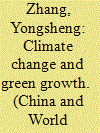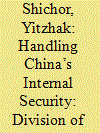| Srl | Item |
| 1 |
ID:
134367


|
|
|
|
|
| Summary/Abstract |
This paper presents a new research agenda on climate change and green growth from the perspective of the division of labor in classical economics. The paper covers three major dimensions of green growth (i.e. carbon emissions, environmental protection and material resources use) and some related important topics, as well as the fresh policy implications of the new research agenda, Typical marginal analysis in a given structure of the division of labor suggests that “green” action is a burden to economic development. Therefore, climate negotiation has become a burden-sharing game and has reached a stalemate. New thinking is badly needed to rescue these negotiations and to drive a shift to a new “green growth” paradigm. The proposed new research agenda represents an effort to create a new narrative on climate change and green growth. Because the new research agenda can theoretically predict the possibility that a more competitive structure of the division of labor could be triggered by “green” policy, it has promising policy implications for various important challenges facing us in the 21st century.
|
|
|
|
|
|
|
|
|
|
|
|
|
|
|
|
| 2 |
ID:
168237


|
|
|
|
|
| Summary/Abstract |
This paper attempts to connect questions of gender construction and gender-based discrimination in terms of access to “…. Resources…. especially knowledge, power, position and culture…. and contribute….” to gender sensitive ethnographic studies; to examine occupational, structural and power inequalities within the tribal village setting of Boddaputtu and Borrapallam. It focuses on the economic conditions, the determinants by which labor is divided, and how these two systems “intertwine,” all of which influence how aspects of gender are constructed and reinforced. The paper highlights that there is division of labor that prescribes certain economic activities to males and certain activities to females.
|
|
|
|
|
|
|
|
|
|
|
|
|
|
|
|
| 3 |
ID:
167489


|
|
|
|
|
| Summary/Abstract |
It is widely assumed that the Chinese People’s Liberation Army (PLA) plays a dominant role in handling internal security. Yet a comparative study shows that regular armed forces prefer to avoid becoming involved in domestic conflicts—and China’s PLA is no exception. Concentrating on Uyghur unrest, the article shows that most of the burden of maintaining internal security in China falls on para-military troops, primarily on the People’s Armed Police Force, the Xinjiang Production-Construction Corps and the Militia, and on non-military outfits, such as the Police and internal security units. Maintaining internal security absorbs an increasing share of China’s defense budget, so much so that in recent years Beijing conceals the figures.
|
|
|
|
|
|
|
|
|
|
|
|
|
|
|
|